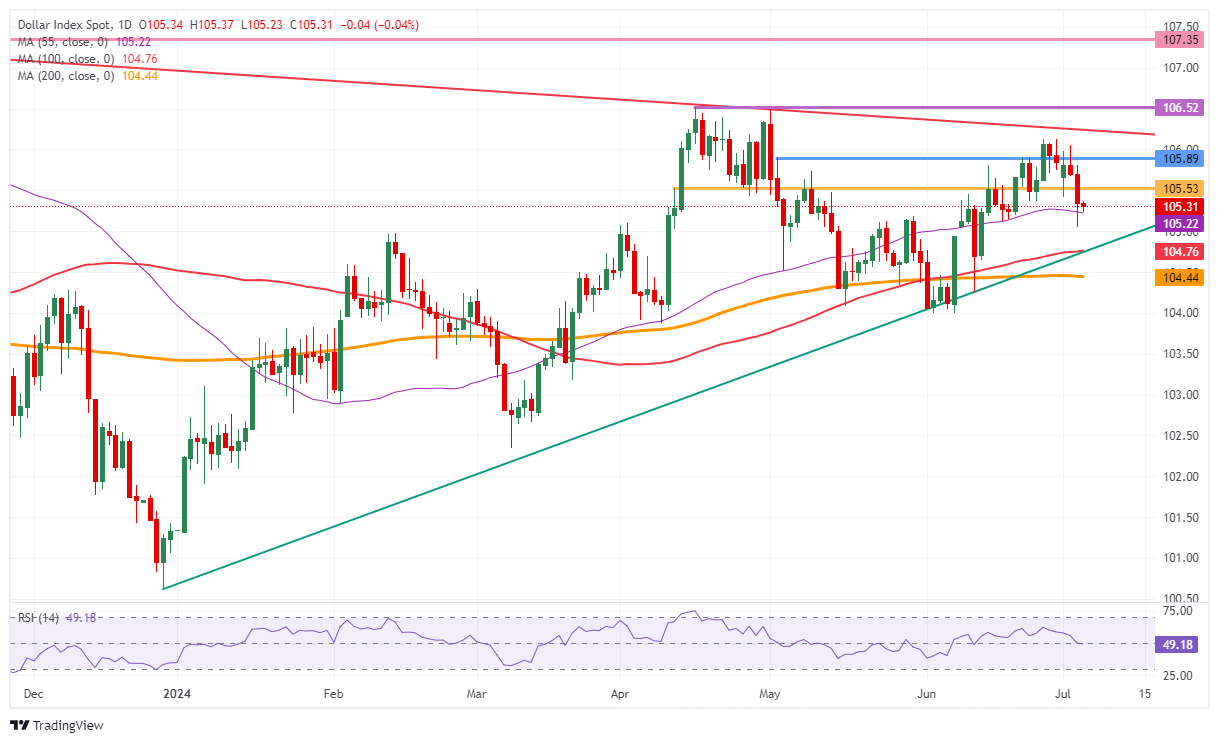US Dollar sees markets calming down with US holiday offering a breather
- The US Dollar eases further after relatively dovish Fed Minutes.
- The focus will be across the Atlantic, with the UK heading to the voting booth.
- The US Dollar index bounces off 105.00, though selling pressure builds.

The US Dollar (USD) and US markets are closed due to Independence Day, though the break is more than welcome with very poor US economic data performance, which triggered some Dollar devaluation in its turn. Despite the public holiday, there is much to digest with several outside events occur on Thursday. The main event that will be building up towards the weekend will be the United Kingdom’s election outcome, where an end to the reign of the Tories party is forecasted after 14 years of being in power.
On the US economic front, an empty calendar ahead, though, as mentioned above, outside data and headlines will drive the Greenback. German Factory Orders already came in at the lowest end of expectations, shrinking -1.6% in May. In addition, the rather disappointing data from Wednesday will still weigh on the US Dollar, with limited upside potential expected for the Greenback.
Daily digest market movers: Election resuls by midnight
- UK citizens are heading to the voting booth. Early results are not expected until late evening and overnight. However, exit polls and comments from key politicians could generate headling in due time. Keeping an eye on the Cable (GBP/USD) will be key for the remainder of the week.
- The New York Times proclaimed that US President Joe Biden is considering withdrawing from the Presidential race.
- The US Federal Reserve Minutes showed the same message as markets heard over the past few weeks: more data is needed to confirm inflation is coming down. However, the Federal Open Market Committee (FOMC) is divided on how long rates need to stay elevated.
- European equities are marginally in the green, along with Asia, where Japan is leading the surge. US futures are flat and are facing less trading volume than usual due to the public holiday.
- The CME Fedwatch Tool is broadly backing a rate cut in September despite recent comments from Fed officials. The odds now stand at 67.3% for a 25-basis-point cut. A rate pause stands at a 26.5% chance, while a 50-basis-point rate cut has a slim 6.2% possibility.
- The US 10-year benchmark rate trades at 4.36%, near its weekly low. Note that the US bond market is closed due to the public holiday.
US Dollar Index Technical Analysis: NFP sees high expectations
The US Dollar Index (DXY) eased quite substantially on Wednesday after a wave of softer US data made the DXY fell to 105.00. Luckily, Dollar bulls came in quickly to salvage the situation and push it back above the 55-day Simple Moving Average (SMA) at 105.32. Though, selling pressure is building on that support with another test early Thursday. Pressure could build in the runup towards Friday, when the Nonfarm Payrolls could be the catalyst that pushes the DXY all the way back to 104.75, which is the next key support.
On the upside, 105.53 and 105.89 are the first nearby pivotal levels. Once a daily close above those levels, the red descending trend line in the chart around 106.23 and the April’s peak at 106.52 are the two main resistances ahead of a fresh nine-month high. That would be reached once 107.35 is broken to the upside.
On the downside, the 55-day SMA at 105.22 safeguard the 105.00 round figure. A touch lower, near 104.76 and 104.44, both the 100-day and the 200-day SMA form a double layer of protection to support any declines together with the green ascending trendline from last December.
US Dollar Index: Daily Chart
Nonfarm Payrolls FAQs
Nonfarm Payrolls (NFP) are part of the US Bureau of Labor Statistics monthly jobs report. The Nonfarm Payrolls component specifically measures the change in the number of people employed in the US during the previous month, excluding the farming industry.
The Nonfarm Payrolls figure can influence the decisions of the Federal Reserve by providing a measure of how successfully the Fed is meeting its mandate of fostering full employment and 2% inflation. A relatively high NFP figure means more people are in employment, earning more money and therefore probably spending more. A relatively low Nonfarm Payrolls’ result, on the either hand, could mean people are struggling to find work. The Fed will typically raise interest rates to combat high inflation triggered by low unemployment, and lower them to stimulate a stagnant labor market.
Nonfarm Payrolls generally have a positive correlation with the US Dollar. This means when payrolls’ figures come out higher-than-expected the USD tends to rally and vice versa when they are lower. NFPs influence the US Dollar by virtue of their impact on inflation, monetary policy expectations and interest rates. A higher NFP usually means the Federal Reserve will be more tight in its monetary policy, supporting the USD.
Nonfarm Payrolls are generally negatively-correlated with the price of Gold. This means a higher-than-expected payrolls’ figure will have a depressing effect on the Gold price and vice versa. Higher NFP generally has a positive effect on the value of the USD, and like most major commodities Gold is priced in US Dollars. If the USD gains in value, therefore, it requires less Dollars to buy an ounce of Gold. Also, higher interest rates (typically helped higher NFPs) also lessen the attractiveness of Gold as an investment compared to staying in cash, where the money will at least earn interest.
Nonfarm Payrolls is only one component within a bigger jobs report and it can be overshadowed by the other components. At times, when NFP come out higher-than-forecast, but the Average Weekly Earnings is lower than expected, the market has ignored the potentially inflationary effect of the headline result and interpreted the fall in earnings as deflationary. The Participation Rate and the Average Weekly Hours components can also influence the market reaction, but only in seldom events like the “Great Resignation” or the Global Financial Crisis.
Author

Filip Lagaart
FXStreet
Filip Lagaart is a former sales/trader with over 15 years of financial markets expertise under its belt.


















